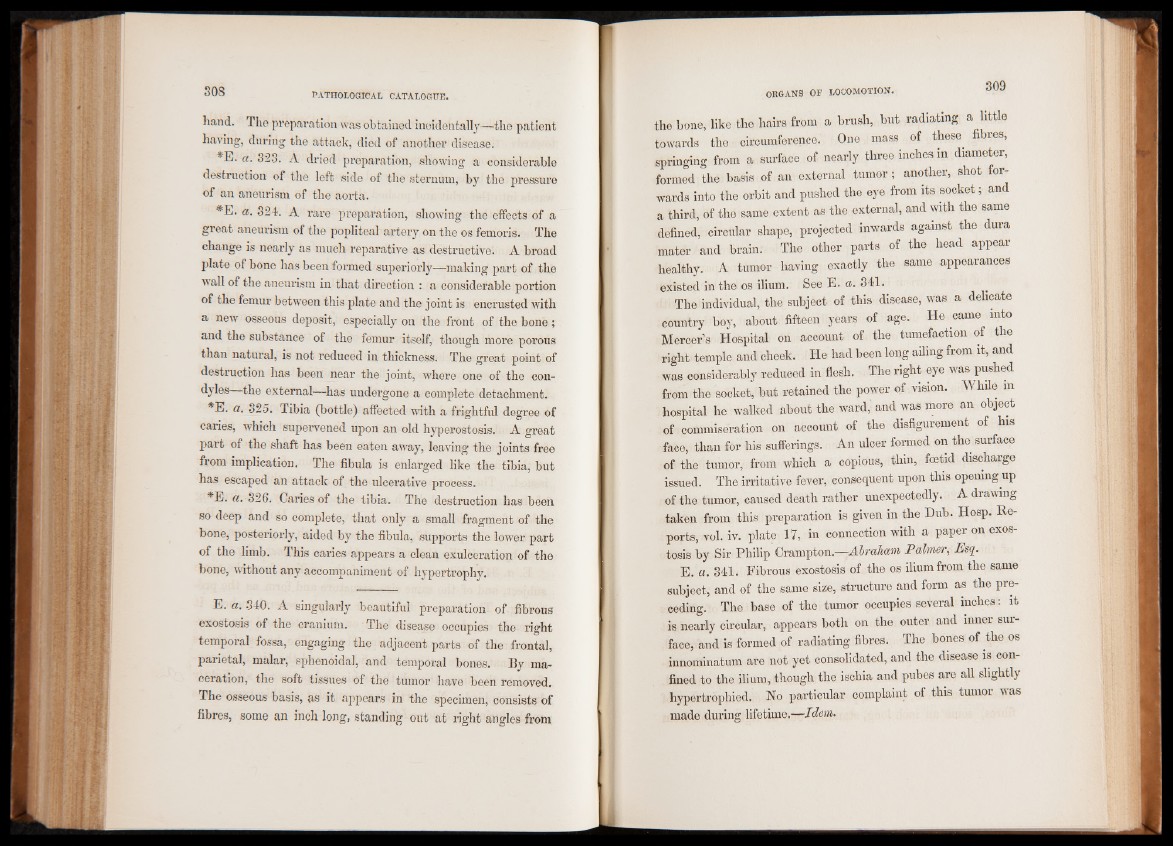
hand. The preparation was obtained incidentally—the patient
having, during the attack, died of another disease.
*E. a. 323. A dried preparation, showing a considerable
destruction of the left side of the sternum, by the pressure
of an aneurism of the aorta.
*E. a. 324. A rare preparation, showing the effects of a
great aneurism of the popliteal artery on the os femoris. The
change is nearly as much reparative as destructive. A broad
plate of bone has been formed superiorly—making part of the
wall of the aneurism in that direction : a considerable portion
of the femur between this plate and the joint is encrusted with
a new osseous deposit, especially on the front of the bone;
and the substance of the femur itself, though more porous
than natural, is not reduced in thickness. The great point of
destruction has been near the joint, where one of the condyles
the external—has undergone a complete detachment.
*E. a. 325. Tibia (bottle) affected with a frightful degree of
caries, which supervened upon an old hyperostosis. A great
part of the shaft has been eaten away, leaving the joints free
from implication. The fibula is enlarged like the tibia, but
has escaped an attack of the ulcerative process.
*E. a. 326. Caries of the tibia. The destruction has been
so deep and so complete, that only a small fragment of the
bone, posteriorly, aided by the fibula, supports the lower part
of the limb. This caries appears a clean exulceration of the
bone, without any accompaniment of hypertrophy.
E. a. 340. A singularly beautiful preparation of fibrous
exostosis of the cranium. The disease occupies the right
temporal fossa, engaging the adjacent parts of the frontal,
parietal, malar, sphenoidal, and temporal bones. By maceration,
the soft tissues of the tumor have been removed.
The osseous basis, as it appears in the specimen, consists of
fibres, some an inch long, standing out at right angles from
the bone, like the hairs from a brush, but radiating a little
towards the circumference. One mass of these fibres,
springing from a surface of nearly three inches in diameter,
formed the basis of an external tumor; another, shot forwards
into the orbit and pushed the eye from its socket; and
a third, of the same extent as the external, and with the same
defined, circular shape, projected inwards against the dura
mater and brain. The other parts of the head appear
healthy. A tumor having exactly the same appearances
existed in the os ilium. See E. a. 341.
The individual, the subject of this disease, was a delicate
country boy, about fifteen years of age. He came into
Mercer’s Hospital on account of the tumefaction of the
right temple and cheek. He had been long ailing from it, and
was considerably reduced in flesh. The right eye was pushed
from the socket, but retained the power of vision. While m
hospital he walked about the ward, and was more an object
of commiseration on account of the disfigurement of his
face, than for his sufferings. An ulcer formed on the surface
of the tumor, from which a copious, thin, foetid discharge
issued. The irritative fever, consequent upon this opening up
of the tumor, caused death rather unexpectedly. A drawing
taken from this preparation is given in the Dub. Hosp. Reports,
vol. iv. plate 17, in connection with a paper on exostosis
by Sir Philip Crampton.—-Abraham Palmer, Esq.
E. a. 341. Fibrous exostosis of the os ilium from the same
subject, and of the same size, structure and form as the preceding.
The base of the tumor occupies several inches : it
is nearly circular, appears both on the outer and inner surface,
and is formed of radiating fibres. The bones of the os
innominatum are not yet consolidated, and the disease is confined
to the ilium, though the ischia and pubes are all slightly
hypertrophied. No particular complaint of this tumor was
made during lifetime.—Idem.